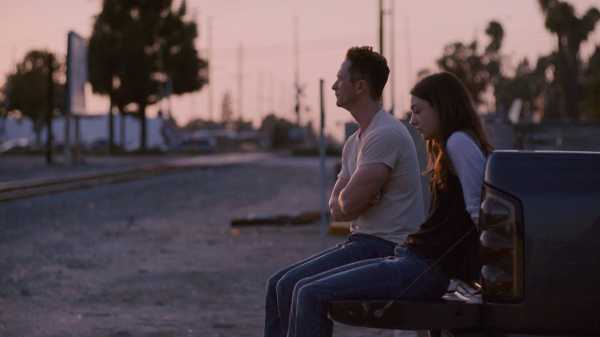
The power and the burden of personal experience inform and energize Jamie Dack’s first feature, “Palm Trees and Power Lines.” (Dack offers an account of this personal inspiration in my colleague Dana Goodyear’s Talk of the Town piece, in the current issue of The New Yorker.) Though a unified drama that maintains a consistent tone from start to finish, “Palm Trees and Power Lines” (currently in theatres and also streaming) is a widely varying film, and both Dack’s finest directorial inspirations and some unfortunate directorial shortcuts appear equally bound to the movie’s personal side, in ways that demonstrate the challenges that filmmakers face when they dramatize parts of their own lives.
“Palm Trees and Power Lines” is set in the summertime in a suburb in Southern California, where a seventeen-year-old high-school student named Lea (Lily McInerny) has little to do between school years. Lea lives with her mother, Sandra (Gretchen Mol), a real-estate agent with a succession of boyfriends whom she entertains at night in the house, to Lea’s dismay. Lea feels neglected and even unwanted; she has little if any contact with her father, who lives in another state. She does little but sunbathe and hang out with friends, at a mall or a doughnut shop or someone’s house. Her boredom is apparent, as is her sense of restless detachment from her friends, whom she finds goofy—especially the male ones, whose goofiness is the spark of the story. She’s out one night with three of them, plus a female friend, at a diner; the guys have the bright idea to run out without paying the check, and Lea and the other girl, bewildered at being stuck there, also bolt. A male employee catches Lea in the parking lot and slaps her; a man intervenes, forcing the aggressor away. Lea walks home, and the man, Tom (played by Jonathan Tucker), follows her, ostensibly to be sure she’s safe, then offers her a ride, which she accepts.
The movie is the story of a grooming. Tom, who says he’s thirty-four, never hides his desire to go out with Lea—he gives her his phone number, although, at first, it seems unlikely that she’ll call. Yet, the next day, she hints to her friend Amber (Quinn Frankel) of her attraction to someone—unwilling to speak frankly about him, doubtless because of his age, she evasively refers to as a student from another school. When, that day, Lea’s mother plans to entertain a man, Lea feels completely out of place at home and reaches out to Tom. He pays attention to her, he lavishly compliments her, he’s tender with her—and he’s coaxing her into a relationship that she’s interested in for its own sake but that he’s instrumentalizing for some other nefarious purpose.
Everything in the film builds to the revelation of that purpose. There are hints dropped along the way. Yet the revelation, when it arrives, is a shock nonetheless, to Lea and to viewers. The horror of what Tom has in store becomes clear in a powerful, agonizing scene that Dack films with a supreme inspiration of empathy and understanding distilled into a single, fixed-frame, five-minute-plus shot, during which the anguish of anticipation yields to terror and revulsion. (There’s a single sound on the soundtrack, a tiny beep, that resounds in the scene with a monstrous, implacable authority.)
From the time that Lea first meets Tom to the climactic revelation, the drama involves the details of Tom’s arachnid scheme and how Lea gets ever more deeply enmeshed in it. Each line of Tom’s dialogue seems precisely honed to her vulnerabilities as he leads her, step-by-step, into his grasp. Which is to say that its specific details are all a part of a relentless, abstract mechanism of Tom’s own design and that Dack (who wrote the script with Audrey Findlay) lays out with an X-ray-like display of its insidious power. This scheme reflects a universality, an overarching diagnostic insight regarding the psychological bond between predator and prey—that is the movie’s crucial conceptual insight.
Yet, strangely, that very sense of abstraction, far from crystallizing over time in the course of the action, only works to hollow the movie out. The emptiness is in the character of Lea—not in the emptiness of her days or the unfulfillment of her life but in the simple and glaring lack of characteristics, traits, interests, ideas, and observations of her daily life—turning her into some blanked-out generality of a suburban teen-age girl. There is no person in the world with as few traits as the movie grants Lea. She has no summer job (where does her money come from? The movie never lets on); she has no apparent interests, no sense of pop culture, no ethnicity, no religion, no politics.
In The New Yorker, Dack explains that, at seventeen, she had a relationship with a thirty-three-year-old man but that no such grooming resulted. The dramatic outcome that she builds from the core of an experience is boldly and meticulously imaginative, as strong in concept as it is in its details. Yet Dack, in eliding herself from the story, replaces the missing details with nothing. The reduction of the protagonist eliminates the complexities of experience, the tangle of inner life, and the clamor of the inner voice. The character is subordinated to—and nearly effaced by—an inherited template regarding what a movie story is and how it’s told.
That template is anchored in psychology, in the creation of a protagonist with exactly the traits that are causally related to Lea’s key actions. What little we do know about Lea—her troubled relationship with her mother, her absent father, her boredom, and her uneasy bonds with her friends—manifestly contributes to her decision to call Tom, to get involved with Tom, to allow herself to trust Tom—despite the warning signs that crop up along the way. There’s only one aspect of Lea’s personality that the movie presents as (nearly) irreducible—namely, desire, the fact that she is indeed attracted to Tom, more or less from the start. (Even this, however, is tethered to another plot point, involving her unsatisfying hookup with one of her male friends.) The elements of character that lead Lea ahead to the film’s devastating crisis—and that pull this moment back into the undercurrent of causality—are, perhaps rightly, treated as dramatically necessary, but they are not sufficient. The aesthetic that packages them as such, that creates a character almost exclusively from the sum total of the psychological minimum, gives the entire movie a spareness that turns its images into information dispensers, nearly devoid of observation and curiosity.
There’s no such thing as a problem with a movie’s substance that isn’t also one of cinematic form. With “Palm Trees and Power Lines,” Dack seems to have forced a copious personality—whether her own or Lea’s—into a framework that fits it poorly. When the payoff comes, it’s too little and late. It’s a contemporary story that feels as if it has been worn away to a featureless, atemporal perfection of the sort that has been handed down, in the industry, through producers’ dictates and story conferences, and which filters into the world of independent filmmaking by way of film schools and handbooks, rounds of workshops and mentoring. Dack’s formidably original perspective and temperament seem formatted away to the vanishing point. ♦
Sourse: newyorker.com






